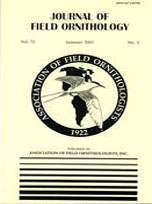Managing for the endangered Red-cockaded Woodpecker (Picoides borealis) on federal lands requires burning large tracts of mature pine forests every 3–5 yr. Many cavity trees that serve as potential nest sites for primary and secondary hole-nesting birds are destroyed by fire. We assessed the efficacy of a nest box program for the Great Crested Flycatcher (Myiarchus crinitus) at Carolina Sandhills National Wildlife Refuge, an area intensively managed for Red-cockaded Woodpeckers. During 1996–1998, we installed and monitored 330 (30 in each of 11 sites) nest boxes in mature (>60 yr) longleaf pine (Pinus palustris) tracts that were burned either in April–June (warm season) or December–March (cool season). Prescribed-burned sites were nearly devoid of snags; we estimated only 0.8/ha in cool-season burns and 1.7/ha in warm-season burns. Great Crested Flycatchers built nests in 20% of the boxes available to them. Clutch sizes were larger in warm-season burns than in cool-season burns, but fledging success (fledglings/nest hatching ≥1 egg) was lower. Twenty-two of 59 Great Crested Flycatcher nests were depredated and the proportions in each burn class were similar. We recommend the installation of nest boxes for Great Crested Flycatchers in prescribed-burned pine forests, but additional research is needed in these habitats on nest depredation rates and causes.
How to translate text using browser tools
1 January 2000
NEST BOX USE AND PRODUCTIVITY OF GREAT CRESTED FLYCATCHERS IN PRESCRIBED-BURNED LONGLEAF PINE FORESTS
Donald H. White,
John T. Seginak
ACCESS THE FULL ARTICLE
It is not available for individual sale.
This article is only available to subscribers.
It is not available for individual sale.
It is not available for individual sale.

Journal of Field Ornithology
Vol. 71 • No. 1
January 2000
Vol. 71 • No. 1
January 2000




